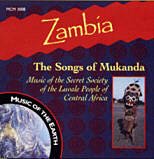 |
EOL CD review Zambia. The Songs of the Mukanda: Music of the Secret Society of the Luvale People of Central Africa Produced by Yuji Ichihashi, Aki Sato, and Stephen
McArthur. Recorded by Ken'ichi Tsukada. Multicultural
Media: Music of the Earth MCM3008. 1997. Compact disc. Liner
notes by Ken'ichi Tsukada; photos and map. |
| The Songs of the Mukanda is a
focused presentation of how music is integral to the initiation ceremonies of the Luvale
people of Zambia. Focusing on how song—as opposed to rhythm—is central to mukanda
the initiation rites of puberty for boys aged nine to fourteen, this CD offers a valuable
addition to the study of how music is central to life-cycle events and celebrations.
Thirteen tracks of varying duration (one to twenty minutes) include multiple examples of
songs according to category. For example, "Sunset songs" has six songs around
thirty seconds each, featuring call and response with chorus. By limiting his criteria for
song selection to the mukanda boys’ period of seclusion, anthropologist and
ethnomusicologist Tsukada Ken’ichi provides rich material for scholarly research. Recorded during two fieldwork visits in 1982 and 1984, some selections are in mono, others are in stereo. Tsukada uses indigenous terms for song names, ceremonies, participant roles, clothing, costumes, and some instrumentation such as mgnwengwe, sticks that symbolize human bones. He does not mention local names for drums nor their functions in mukanda songs and ceremonies. This is curious, since mukanda is a male initiation rite and men play the drums. However, the focus is on songs, and most examples are voice with hand clapping accompaniment. Tsukada provides song characteristics such as intervals and meter and includes English translations of song content and relevant Luvale phrases. The liner notes, entitled "field notes," by Tsukada are informative and descriptive. They provide a general precolonial and postcolonial history of the Luvale who inhabit Zambia, Zaire and Angola. Tsukada further describes his entrance and acceptance into Luvale society and he describes his fieldwork methodology. Following the "field notes" section are six pages of descriptive material for each track. Dates of the recording and location are included. Synopsis of cultural significance of the song and description of the event are used for each track. Some tracks have multiple examples which are not always fully described. |
|
|
|
Significant in this CD’s presentation
of mukanda music is Tsukada’s solution to recording music played between two
parties over long distances. For example, the Kukuwa (Audio 1, "shouts of
jubilation") songs of teachings and moral values sung by men every few nights near
the initiates lodge are responded to by the women in the nearby village presents a
logistical problem. Tsukada records each party on different nights and places them on
different tracks instead of editing them together. Further, he records different villages
so we are able to compare two different areas. Another astonishing track is #7, when
Tsakada follows a boy returning from a spring with water from the lodge (Audio 2). There
is a call coming from the boy and a response from the initiates in the lodge. As the boy
closes the distance the responses from the lodge become louder, increasing the intensity
of the moment.
|
| Overall, this is a CD that focuses well on a specific
event providing in-depth documentation beneficial to scholars studying music integral to
African life.
Timothy Mangin is a doctoral student in ethnomusicology at Columbia University. He is currently researching Mbalax and Sabar music from Senegal where he conducted field research in 1997. His past work has focused on American popular music, specifically jazz, acid jazz, and hip hop. |
|